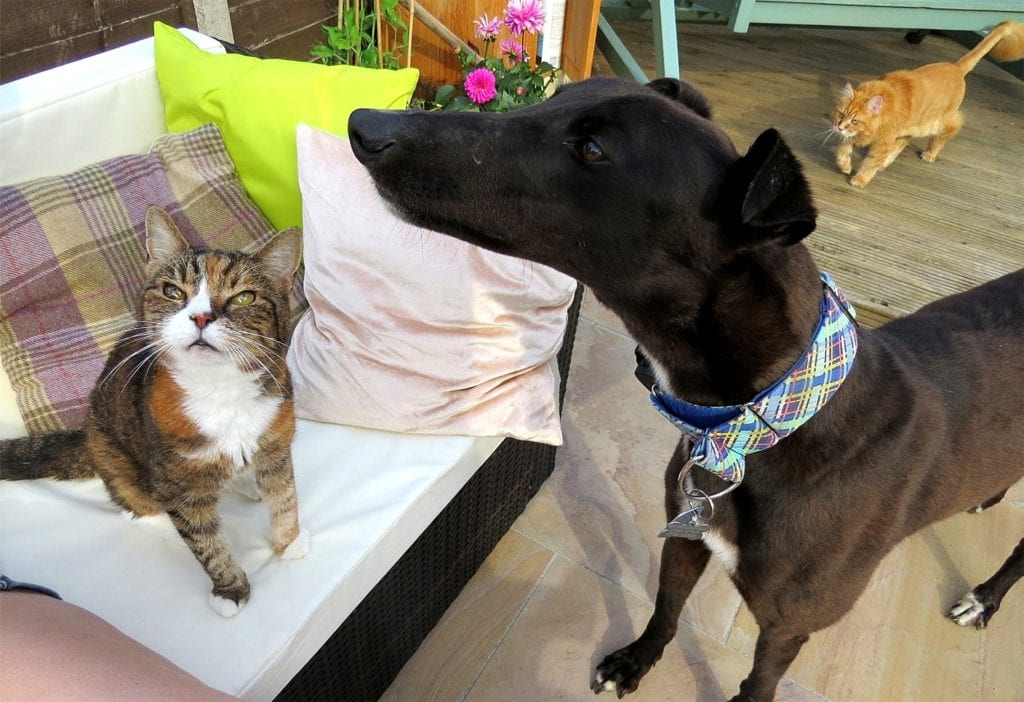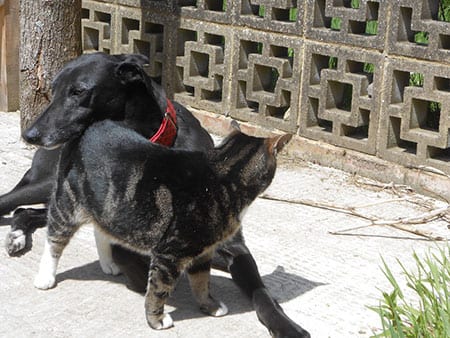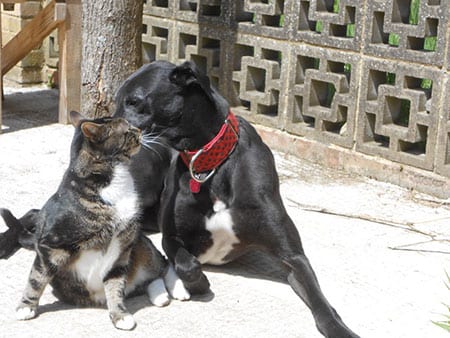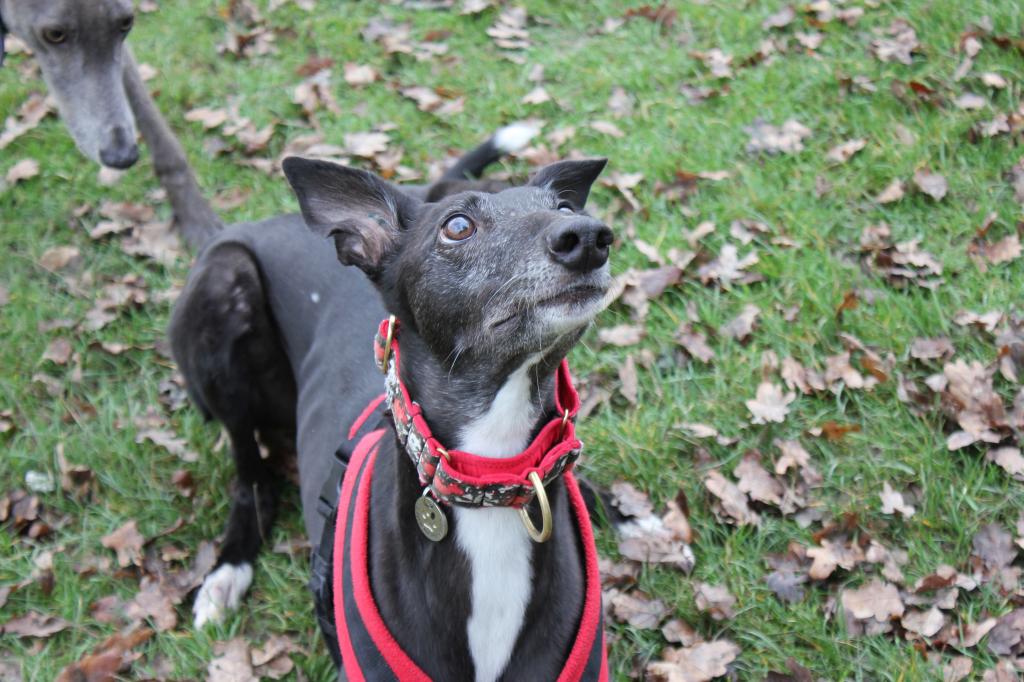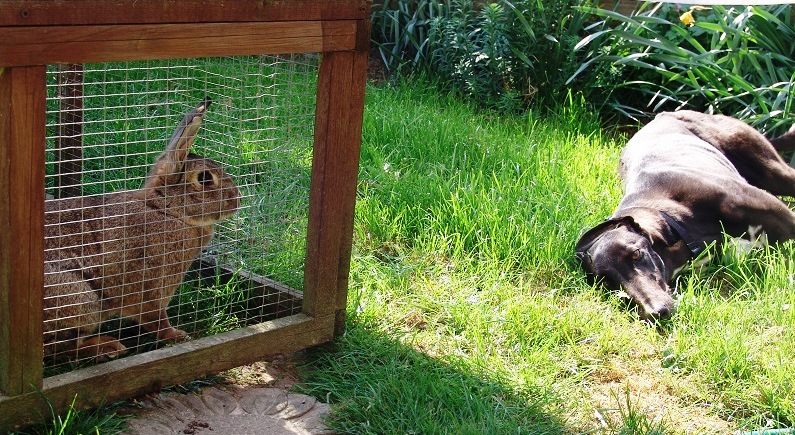Not all greyhounds and lurchers can live with cats, BUT some can. However the whole process of detraining takes significant time and patience and should not be entered into lightly.
Greyhound And Cats
Can greyhounds live with cats? Read our guidance.
Not all greyhounds and lurchers can live with cats, BUT some can. However the whole process of detraining takes significant time and patience and should not be entered into lightly. Above all it takes confidence from the new owners. Your new greyhound will probably get very excited at meeting your cat so you need to keep calm and be in control of the situation.
Be prepared! this is the key to making it work.
You will have restless nights, your stress levels will increase and there may be times when you think it will not work. But just remember, once everything has settled down, it will all be worth it. It is not just greyhounds and lurchers who chase cats. Most dogs need careful introductions.
We only cat test our greyhounds and lurchers to see which dogs we think will be suitable to live with cats. We do not train them for you. You will need to put in the time and effort once you have adopted your new greyhound to make sure all animals can live happily together. If the dog is suitable for training we will note him as cat workable on his rehoming advert. Very rarely do we get a greyhound or lurcher who has lived in a home with a cat. If that is the case his rehoming advert will say cat friendly.
You will also have to be comfortable with using a crate/indoor kennel or the whole process may not work. Please be aware that the dog may object strongly to being placed in a crate. So you have to be strong and not give in to the tantrums. You need to make the crate really appealing to your greyhound so he decides he wants to be inside it. But you will have to be patient whilst he makes that decision. This is a short term issue which will benefit the whole family in the long run but you need to stay firm.
Greyhounds, cats and children.
For the above reasons we do not rehome greyhounds or lurchers to families with both children and cats. Because, in the past too many dogs have been returned. The dogs were returned because either:
- the family didn’t have the time to train the dog properly,
- the children did not fully understand the importance of keeping the dog (or cat) in the crate, or
- the children were upset if the dog barked at the cats.
Before you adopt. This is really important!
Your cat needs you!
Make sure the cat is indoors before you go to collect your new dog. If your cat is nervous you may need to plan to keep the cat indoors for around 2 weeks. So, you will also to think about litter trays etc. Keeping your cat indoors also ensures that he cannot take offence and go to find a new home next door. Please remember your cat was in residence first and you need to make him feel involved and loved.
Get the crate ready for the big day
Before collecting your new greyhound you should make a comfortable and appealing den for him, inside a crate. This needs to be set up in the room that the family uses the most. The crate allows everyone to keep calm in the first few days. You will be less stressed and your greyhound will be less stressed. And, importantly, your cat cannot come to any harm.
If we have a crate available at the time of adoption we are happy to lend it to you for a few weeks on the understanding that it will be your responsibility to collect and then return it. We only have a limited supply, so we cannot guarantee we will have one available. We do ask for a deposit of £50 to ensure that the crate is returned to kennels after use. The deposit will be returned to you as soon as the crate is returned to KGR.
Arriving home – let the fun begin!
On arriving home with your new greyhound, ensure that he is muzzled. Then ensure he has a correctly fitting collar, harness and is on a strong double ended lead. We sell all of these items in our online shop.
Be confident – your greyhound will be wearing a muzzle so the cat is protected should you accidentally drop the lead. Your greyhound will sense if you are nervous or worried. You MUST remain calm and confident at all times. If you feel yourself getting nervous and tense – sing to the dog or act silly! If you do this, you send out happy signals not stressy ones.
Introduce your new greyhound or lucher to the cat. If the greyhound gets excited and lunges for the cat – firmly say NO and mean NO. At this point you need to be very firm so your new hound knows it is not acceptable to chase the cat. Once he stops reward him with a tasty treat and lots of fuss.
Remember to allow your cat to be in charge. A good smack from the cat always helps and will serve as a reminder to the hound not to mess. Never stop the cat from trying to be the boss.
Try to keep the greyhound and cat and the rest of your family in the same room for as much time as possible. This allows the dog to realise the cat is part of the family. He will then gradually lose interest in the cat. After the initial meeting keep either the dog or the cat in the crate. Always allow the one not crated to go up to the crate and meet the other animal.
Don’t take any shortcuts
The more your dog and cat get used to each other – the quicker the process will be. If you keep them apart, the training will take much longer.
Only when you are sure can you gradually let the dog out of the crate when you are in the room, and get him used to the cat. At this point you can take off the muzzle, but keep the dog on a lead and harness.
Always correct bad behaviour with a firm NO and good behaviour with a tasty treat.
Keep going – it will be hard work.
Never allow your greyhound and cat to be alone in the same room until you are 100% sure they have accepted each other. Even when you are 100%, only leave them for very short periods. And then always in a place where you can keep an eye on them and intervene if necessary.
Don’t be worried if you don’t see an improvement within a few days. The whole process can take many weeks for any signs it is going to work. It could be 2-3 months before you can be sure.
Do not be in a rush, it will take as long as it takes. Don’t take risks or shortcuts.
Desensitising a greyhound to cats requires a lot of:
- discipline,
- patience,
- confident handling,
- consistency from everyone
- ability to read the body language your dog and cat are telling you.
The good news is lots of greyhounds and lurchers live happily with cats, so it can be done. Just make sure you adopt a cat workable dog and follow the rules carefully.
What to do next
Lots of our dogs are “failed racers”. This means they were dumped by the owner or trainer as there were not going to win races. They are often much younger than retired racers. Please remember younger dogs needs more walking. They are not always lazy sofa hounds.
If you want to proceed – the next step is to complete the online adoption form.
We do rehome throughout the UK so long as you are willing to travel to Kent. We explain a lot more about the rehoming process in our FAQs and in the rehoming section. Please see our current greyhounds and lurchers looking for homes here
Do you follow us on Facebook and Instagram?
Everyone at Kent Greyhound Rescue is a volunteer. Our online shop really helps us to pay our kennel and vets bills. We sell everything you need for your dog and all proceeds help the rescue.

